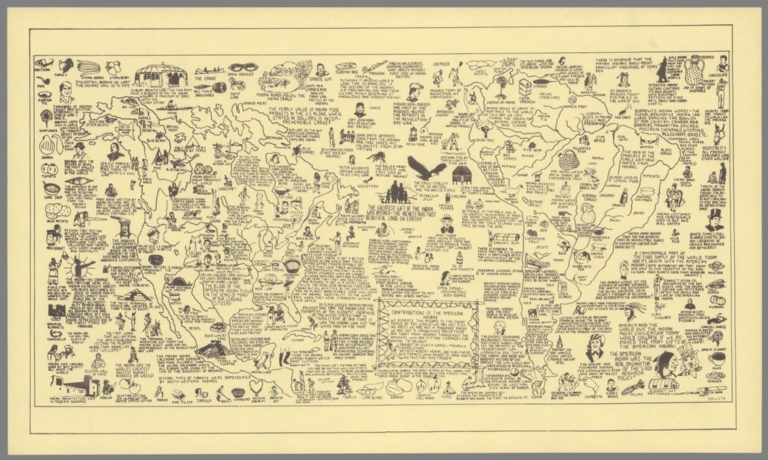COLLECTION NAME:
David Rumsey Historical Map Collection
Record
Author:
Fadden, Ray
Date:
1945
Short Title:
Contributions of the American Indians.
Publisher:
Ray Fadden
Type:
Separate Map
Obj Height cm:
26
Obj Width cm:
51
Note:
Date estimated.
World Area:
America
Subject:
Pictorial map
Subject:
Historical
Subject:
Indians
Full Title:
Contributions of the American Indians.
List No:
15783.000
Publication Author:
Fadden, Ray
Pub Date:
1945
Pub Title:
Contributions of the American Indians.
Pub Note:
"Ray Fadden was born on Aug. 23, 1910, in a farmhouse owned by his grandparents five miles east of the hamlet of Onchiota. During his life, he traveled to American Indian communities throughout the state and visited many northeastern museums to view collections of Native culture, according to his obituary. While teaching at the elementary school on the Tuscarora Reservation, near Niagara Falls, he met Christine Chubb, a young woman from Akwesasne. They married in 1935. While at Tuscarora, Fadden became friends with Clinton Rickard, founder of the Indian Defense League of America. They worked together on a number of projects. Fadden, a science teacher, later taught at the St. Regis Mohawk School in Hogansburg. It was there he educated and inspired generations of Mohawk children, including the mother of Katherine "Kay" Olan of Saratoga. Olan first met Fadden when he was building the museum. She was 12. She credits him with encouraging her as a storyteller. Over decades, Olan listened to Fadden's stories. His tales advocated respect not only for native people and their traditions but for all people and living things in the natural world. "He would always make time to sit and give people a chance to ask questions," Olan said. "He would tell a story, talk about the environment and be real quiet. He would take out his pipe and say, Don't tell Christine.'" He opened the floor for discussion for native and non-native people, children and elders, alike. "I just think the richness of our experience as Haudenosaunee people and human beings, regardless of your background, would not be as rich without Ray, who kept our eyes open and ears open and lifted the spirit of the people who met him," Olan said. Former student Dee Brown said it was impossible to put Fadden's phenomenal life into words. "Ray Fadden will live forever in the legacy he has left behind," said Brown via e-mail. The Malone resident is a retired North Country Community College development director. "He taught us to be proud of ourselves and respect our heritage. He was my inspiration to start a Mohawk language course when I worked at North Country Community College. Ray worked tirelessly to dispel stereotypes and give credit to the Native peoples for their many contributions to society. He is truly a legend." In the early 1940s, Fadden created the Akwesasne Mohawk Counselor Organization, designed to educate Mohawk children about Native history, woodcraft technologies and Mohawk traditions and to develop a positive self-image. During the early 1940s, Fadden began publishing a series of educational pamphlets and charts, which included collections of Iroquois legends, histories of Iroquois groups and individuals, plus other facets of American Indian history. A total of 27 pamphlets and about 40 charts were published. In the 1990s, the Book Publishing Company of Summertown, Tenn., issued three compilations of his work: "Legends of the Iroquois," "Wampum Belts of the Iroquois" and "Roots of the Iroquois." In the 1950s, Fadden began the process of creating the Six Nations Indian Museum near Onchiota. The museum opened in June 1954. He left St. Regis Mohawk School in 1957 to teach seventh-grade science at Saranac Central School. He retired from Saranac in 1967. Singer-songwriter Roy Hurd was a student. "I wouldn't be the same person I am today if it wasn't for Ray and Christine Fadden," said Hurd, who lives in Lake Clear. "He was like my elder brother, my grandfather, my teacher, my friend. Ray was the most passionate person I ever met about things he believed in." Hurd pointed out that Fadden influenced many future Mohawk leaders, including Jake Swamp, Tommy Porter and Joyce Benedict. "He rescued the nation," Hurd said. "The culture was being suppressed so badly. All in all, he was awesome." Hurd recalled the summer Fadden turned 90. "He said, Poncho, I'm slowing down. I'm only feeding the birds in 200 places in the woods instead of 300 places.'" Artist, poet and environmentalist Jeff Cochran only heard Fadden speak once, but that was enough to impact how he delivers Native-American teachings today. "I was just moved by the clarity of his passion," said Cochran, who lives in Plattsburgh. "Some of his messages were mostly brand new and very different from what other people know about Native Americans and their relationship to the United States government. That is what he taught me, and I got it in a positive way." (Robin Caudell, Press Republican Newspaper, Nov 18, 2008)
Pub List No:
15783.000
Pub Type:
Separate Map
Pub Height cm:
26
Pub Width cm:
51
Image No:
15783000.jp2
Authors:
Fadden, Ray
